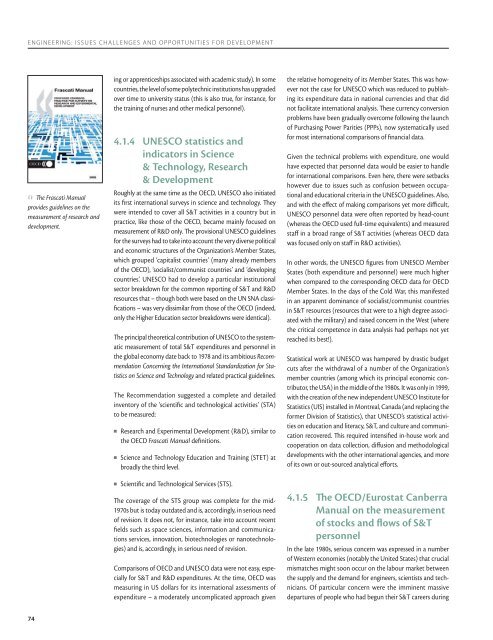Engineering: issues, challenges and opportunities for development ...
Engineering: issues, challenges and opportunities for development ...
Engineering: issues, challenges and opportunities for development ...
Create successful ePaper yourself
Turn your PDF publications into a flip-book with our unique Google optimized e-Paper software.
ENGINEERING: ISSUES CHALLENGES AND OPPORTUNITIES FOR DEVELOPMENT The Frascati Manualprovides guidelines on themeasurement of research <strong>and</strong><strong>development</strong>.ing or apprenticeships associated with academic study). In somecountries, the level of some polytechnic institutions has upgradedover time to university status (this is also true, <strong>for</strong> instance, <strong>for</strong>the training of nurses <strong>and</strong> other medical personnel).4.1.4 UNESCO statistics <strong>and</strong>indicators in Science& Technology, Research& DevelopmentRoughly at the same time as the OECD , UNESCO also initiatedits first international surveys in science <strong>and</strong> technology. Theywere intended to cover all S&T activities in a country but inpractice, like those of the OECD , became mainly focused onmeasurement of R&D only. The provisional UNESCO guidelines<strong>for</strong> the surveys had to take into account the very diverse political<strong>and</strong> economic structures of the Organization’s Member States,which grouped ‘capitalist countries’ (many already membersof the OECD ), ‘socialist/communist countries’ <strong>and</strong> ‘developingcountries’. UNESCO had to develop a particular institutionalsector breakdown <strong>for</strong> the common reporting of S&T <strong>and</strong> R&Dresources that – though both were based on the UN SNA classifications– was very dissimilar from those of the OECD (indeed,only the Higher Education sector breakdowns were identical).The principal theoretical contribution of UNESCO to the systematicmeasurement of total S&T expenditures <strong>and</strong> personnel inthe global economy date back to 1978 <strong>and</strong> its ambitious RecommendationConcerning the International St<strong>and</strong>ardization <strong>for</strong> Statisticson Science <strong>and</strong> Technology <strong>and</strong> related practical guidelines.The Recommendation suggested a complete <strong>and</strong> detailedinventory of the ‘scientific <strong>and</strong> technological activities’ (STA)to be measured:■■■Research <strong>and</strong> Experimental Development (R&D), similar tothe OECD Frascati Manual definitions.Science <strong>and</strong> Technology Education <strong>and</strong> Training (STET) atbroadly the third level.Scientific <strong>and</strong> Technological Services (STS).The coverage of the STS group was complete <strong>for</strong> the mid-1970s but is today outdated <strong>and</strong> is, accordingly, in serious needof revision. It does not, <strong>for</strong> instance, take into account recentfields such as space sciences, in<strong>for</strong>mation <strong>and</strong> communicationsservices, innovation, biotechnologies or nanotechnologies)<strong>and</strong> is, accordingly, in serious need of revision.Comparisons of OECD <strong>and</strong> UNESCO data were not easy, especially<strong>for</strong> S&T <strong>and</strong> R&D expenditures. At the time, OECD wasmeasuring in US dollars <strong>for</strong> its international assessments ofexpenditure – a moderately uncomplicated approach giventhe relative homogeneity of its Member States. This was howevernot the case <strong>for</strong> UNESCO which was reduced to publishingits expenditure data in national currencies <strong>and</strong> that didnot facilitate international analysis. These currency conversionproblems have been gradually overcome following the launchof Purchasing Power Parities (PPPs), now systematically used<strong>for</strong> most international comparisons of financial data.Given the technical problems with expenditure, one wouldhave expected that personnel data would be easier to h<strong>and</strong>le<strong>for</strong> international comparisons. Even here, there were setbackshowever due to <strong>issues</strong> such as confusion between occupational<strong>and</strong> educational criteria in the UNESCO guidelines. Also,<strong>and</strong> with the effect of making comparisons yet more difficult,UNESCO personnel data were often reported by head-count(whereas the OECD used full-time equivalents) <strong>and</strong> measuredstaff in a broad range of S&T activities (whereas OECD datawas focused only on staff in R&D activities).In other words, the UNESCO figures from UNESCO MemberStates (both expenditure <strong>and</strong> personnel) were much higherwhen compared to the corresponding OECD data <strong>for</strong> OECDMember States. In the days of the Cold War, this manifestedin an apparent dominance of socialist/communist countriesin S&T resources (resources that were to a high degree associatedwith the military) <strong>and</strong> raised concern in the West (wherethe critical competence in data analysis had perhaps not yetreached its best!).Statistical work at UNESCO was hampered by drastic budgetcuts after the withdrawal of a number of the Organization’smember countries (among which its principal economic contributor,the USA) in the middle of the 1980s. It was only in 1999,with the creation of the new independent UNESCO Institute <strong>for</strong>Statistics (UIS) installed in Montreal, Canada (<strong>and</strong> replacing the<strong>for</strong>mer Division of Statistics), that UNESCO’s statistical activitieson education <strong>and</strong> literacy, S&T, <strong>and</strong> culture <strong>and</strong> communicationrecovered. This required intensified in-house work <strong>and</strong>cooperation on data collection, diffusion <strong>and</strong> methodological<strong>development</strong>s with the other international agencies, <strong>and</strong> moreof its own or out-sourced analytical ef<strong>for</strong>ts.4.1.5 The OECD/ Eurostat CanberraManual on the measurementof stocks <strong>and</strong> flows of S&TpersonnelIn the late 1980s, serious concern was expressed in a numberof Western economies (notably the United States) that crucialmismatches might soon occur on the labour market betweenthe supply <strong>and</strong> the dem<strong>and</strong> <strong>for</strong> engineers, scientists <strong>and</strong> technicians.Of particular concern were the imminent massivedepartures of people who had begun their S&T careers during74

















